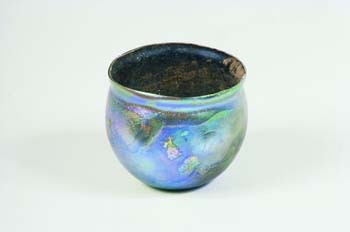Bowl
- 4th-early 5th century CE
- Roman workshop (West Roman) [D. Caccioli]
- Free-blown glass
6.5 x 7.2 x 7.2 cm., 2-1/2 x 2-7/8 x 2-7/8"
- Gift of Estate of Paul A. Anderson through Catherine Carter Goebel, Paul A. Anderson Chair in the Arts, Paul A. Anderson Art History Collection, Augustana College, 2001.8

Essay by Emil A. Kramer, Professor of Classics
The two pieces of Roman glass in our collection wonderfully reflect the story of glass itself, and also reveal some of the many links between antiquity and our present day. Indeed, the first of these (item A), stunningly links ancient Egypt with the cosmetics counter at your local department store. What you are viewing is an ancient eyeliner kit. The basic design of the kit, double tubes to hold the components of the eyeliner and an applicator (missing in our piece), seems to have developed in Egypt during the period of the New Kingdom (ca. 1587-1085 BCE) (Dayagi-Mendels 40-44). Remarkably, the design remained essentially the same into the later Roman Empire (200-400 CE), the period in which blown glass versions of the kit appear to have become popular—a span of almost 2000 years (Caccioli 20). Kits of this sort would have been used to make the highly exaggerated eyes typical of Egyptian portraiture. Surviving applicators are similar to those in modern eyeliner kits: one end was broad and flat, the other pointed (Dayagi-Mendels 36).
The other example of Roman glass in the Paul A. Anderson Collection (item B) carries us across the Mediterranean and into the northernmost reaches of the western Roman Empire where important centers of glass production had grown up around the Roman legionary bases along the Rhine river (Isings 4-13). This diminutive blown glass bowl (Caccioli, notes 4 and 5) would be at home in any kitchen or on any table, ancient or modern. Bowls of this sort were manufactured primarily in cities along the Rhine during the later Roman Empire (from the late 3rd through the 5th century CE), a time when Rome was frequently challenged by incursions of Germanic tribes (Isings 113-114).
Ironically, the remarkable colors that make these pieces so distinctive are accidents of time; both of our pieces were originally a uniform yellowish-green color. The present appearance of the pieces is the result of weathering over the last 1500 years. When glass is exposed alternately to wet and dry conditions over such a span of time, the surface of the glass begins to break down chemically. This process ultimately produced the varied hues of bright green, gold, and blue evident on the eyeliner kit, and the shimmering iridescent patina of the bowl. These transformations serve as a reminder that artifacts of antiquity-material and also literary-sometime acquire meaning and significance never envisioned by their creators.
